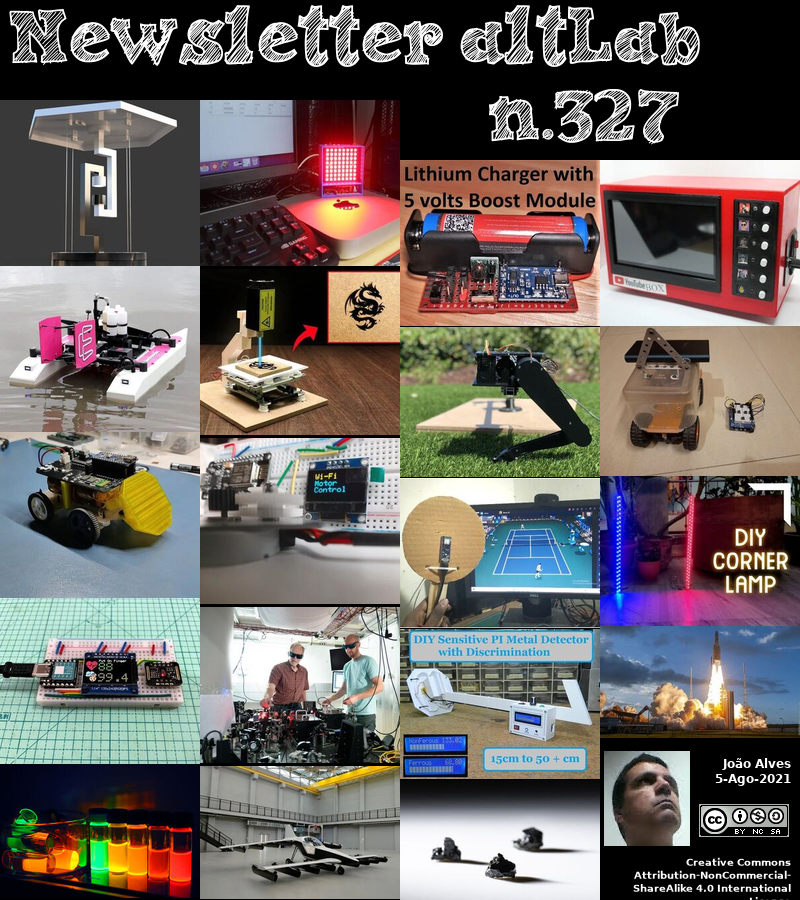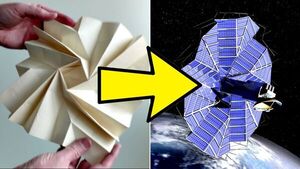2021-08-05 - Nº 327
Editorial
Esta é a Newsletter Nº 327 que se apresenta com o mesmo formato que as anteriores. Se gostar da Newsletter partilhe-a!
Todas as Newsletters encontram-se indexadas no link.
Esta Newsletter tem os seguintes tópicos:
Faz hoje anos que nascia, em 1802, o matemático norueguês Niels Henrik Abel. Ele desenvolveu vários ramos da matemática moderna. Após um início lento na escola, começou a mostrar genialidade matemática aos 15 anos de idade. Em 1823 provou que não havia fórmula algébrica para a solução de uma equação polinomial geral do quinto grau. Ele desenvolveu o conceito de funções elípticas independentemente de Carl Gustav Jacobi, e a teoria dos integrais e funções abelianas tornou-se um tema central da análise do final do século XIX.
Faz também hoje anos que nascia, em 1924, o cientista chinês Huang Hongjia. Ele desenvolveu a teoria das ondas de acoplamento no campo da teoria das micro-ondas. Liderou uma equipa de investigação que desenvolveu com sucesso fibras ópticas mono-modo em 1980.
Por fim, faz hoje anos que nascia, em 1930, o Astronauta norte-americano Neil Alden Armstrong. Ele foi o primeiro homem a caminhar na lua (a 20 de Julho de 1969, Apollo 11). Serviu como piloto da Marinha durante a Guerra da Coreia, tendo depois ingressado no Comité Consultivo Nacional para a Aeronáutica (que se tornou na NASA), como piloto de testes civis. Em 1962, foi o primeiro civil a entrar no programa de treino de astronautas. Ganhou experiência como piloto de comando da missão Gemini 8, que realizou a primeira união física de duas naves espaciais em órbita. Mais tarde, foi comandante da missão lunar da Apollo 11.
Faz hoje 48 anos que era lançada a sonda Mars 6 em direcção a Marte. Esta foi uma das várias sondas soviéticas Mars - 4, 5, 6, e 7 - lançada em Julho-Agosto de 1973. Ao chegar a Marte, o módulo de descida solto-se para a sua missão de estudar a atmosfera e a superfície de Marte. Após 224 segundos de transmissão de dados - os primeiros dados devolvidos da atmosfera de Marte - o contacto com o módulo de descida perdeu-se antes da sua planeada aterragem à superfície. Infelizmente, muitos destes dados eram ilegíveis devido a um chip de computador defeituoso. Foram relatadas informações sobre pressão, temperatura e vapor de água. O módulo de descida continuou a enviar as medições dos seus próprios instrumentos.
Em 1858 era completado o primeiro cabo transatlântico de telegrafo. Estendendo-se por quase 3200 quilómetros através do Atlântico a uma profundidade frequentemente superior a três quilómetros. A 16 de Agosto, o Presidente James Buchanan e a Rainha Vitória trocaram mensagens formais introdutórias e de cortesia. Infelizmente, o cabo revelou-se fraco e a corrente insuficiente e, no início de Setembro, tinha deixado de funcionar.
Nesta semana que passou o satélite EUTELSAT QUANTUM foi lançado com sucesso na órbita de transferência geoestacionária pela Arianespace utilizando um foguete Ariane 5 que descolou do Centro Espacial da Guiana em Kourou, Guiana Francesa, às 21 horas, hora universal (23 horas CET) do dia 30 de Julho. A separação ocorreu após um voo de 37 minutos e a verificação dos sistemas das naves espaciais foi então completada com sucesso durante um período de aproximadamente 3 horas. Construído pela Airbus Defence and Space, o EUTELSAT QUANTUM anuncia uma nova era de serviço comercial via satélite. As suas características reprogramáveis em órbita estabelecem um novo padrão de flexibilidade que permitirá aos utilizadores, nomeadamente nos mercados de Governo e Mobilidade, definir e moldar activamente o desempenho e alcançar graças ao seu desenho baseado em software.
Na Newsletter desta semana apresentamos diversas noticias, artigos científicos, projetos de maker assim como alguns videos interessantes.
 João Alves ([email protected])
João Alves ([email protected])
O conteúdo da Newsletter encontra-se sob a licença  Creative Commons Attribution-NonCommercial-ShareAlike 4.0 International License.
Creative Commons Attribution-NonCommercial-ShareAlike 4.0 International License.
Novidades da Semana
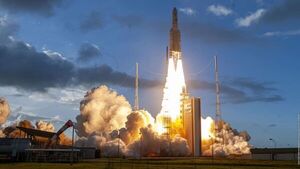
Successful launch of EUTELSAT QUANTUM, the first full software-defined satellite
"The EUTELSAT QUANTUM satellite was successfully launched into Geostationary Transfer Orbit by Arianespace using an Ariane 5 rocket that lifted off from the Guiana Space Center in Kourou, French Guiana, at 9 pm Universal Time (11 pm CET) on July 30. The separation occurred after a 37-minute flight and the spacecraft systems checkout was then successfully completed over a period of approximately 3 hours. Built by Airbus Defence and Space, EUTELSAT QUANTUM heralds a new era of commercial satellite service. Its in-orbit reprogrammable features set a new standard in flexibility that will enable users, notably in the Government and Mobility markets, to actively define and shape performance and reach thanks to its software-based design. To be located at 48° East, and due to enter service during the fourth quarter of calendar 2021, EUTELSAT QUANTUM will offer extensive coverage of the MENA region and beyond. ESA and the UK Space Agency supported the development of the core technologies integrated into EUTELSAT QUANTUM, within the framework of a Public-Private Partnership between ESA, Eutelsat and Airbus Defence and Space." [...]
Outras Notícias
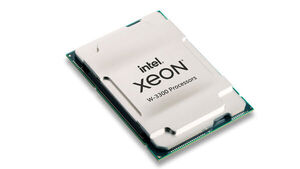
Intel Announces New Xeon W-3300 Processors
"Intel today launched its newest generation Intel® Xeon® W-3300 processors, available today from its system integrator partners. Built for advanced workstation professionals, Intel Xeon W-3300 processors offer uncompromised performance, expanded platform capabilities, and enterprise-grade security and reliability in a single-socket solution. Intel Xeon W-3300 processors are intelligently engineered to push the boundaries of performance, with a new processor core architecture that transforms for what expert workstation users can accomplish on a workstation. Why It Matters: The Intel Xeon W-3300 processors are designed for next-gen professional applications with heavily threaded, input/output-intensive workloads. Use cases stretch across artificial intelligence (AI), architecture, engineering, construction (AEC), and media and entertainment (M&E). With a new processor core architecture to transform efficiency and advanced technologies to support data integrity, Intel Xeon W-3300 processors are equipped to deliver uncompromising workstation performance." [...]

Ready for Prime Time: Plus to Deliver Autonomous Truck Systems Powered by NVIDIA DRIVE to Amazon
"Your Amazon Prime delivery just got smarter. Autonomous trucking company Plus recently signed a deal with Amazon to provide at least 1,000 self-driving systems to retrofit on the e-commerce giant’s delivery fleet. These systems are powered by NVIDIA DRIVE Xavier for high-performance, energy-efficient and centralized AI compute. The agreement follows Plus’ announcement of going public via SPAC, or special acquisition company. Amazon — which leads the U.S. e-tail market, counting $386 billion in net revenue in 2020 — has been investing heavily in autonomous and electric vehicle technology. Last year, it acquired robotaxi company and NVIDIA DRIVE ecosystem member Zoox for $1.3 billion." [...]
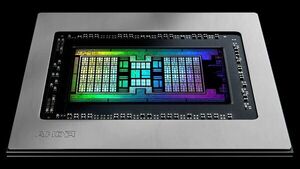
New AMD Radeon PRO W6000X Series GPUs Bring Groundbreaking High-Performance AMD RDNA 2 Architecture to Mac Pro
"AMD today announced availability of the new AMD Radeon™ PRO W6000X series GPUs for Mac Pro. The new GPU product line delivers exceptional performance and incredible visual fidelity to power a wide variety of demanding professional applications and workloads, including 3D rendering, 8K video compositing, color correction and more. Built on groundbreaking AMD RDNA 2 architecture, AMD Infinity Cache and other advanced technologies, the new workstation graphics line-up includes the AMD Radeon™ PRO W6900X and AMD Radeon™ PRO W6800X GPUs. Mac Pro users also have the option of choosing the AMD Radeon PRO W6800X Duo graphics card, a dual-GPU configuration that leverages high-speed AMD Infinity Fabric interconnect technology to deliver outstanding levels of compute performance. “We developed the AMD Radeon PRO W6000X series GPUs to unleash professionals’ creativity and help them bring more complex and compute-intensive projects to life, from animating 3D film assets to compositing 8K scenes to game development,” said Scott Herkelman, corporate vice president and general manager, Graphics Business Unit at AMD. “The new AMD Radeon PRO W6000X series is packed with remarkable energy efficiency, enhanced compute units and a new visual pipeline, enabling Mac Pro users to do more in less time across a broad range of pro applications.” Key capabilities and features of AMD Radeon PRO W6000X series GPUs include: - Award-Winning AMD RDNA 2 Architecture – Built on the 7nm manufacturing process, AMD RDNA 2 architecture offers an array of advanced features elevating professional graphics to new levels of performance and efficiency." [...]

First Aerospace-qualified Baseless Power Module Family Improves Aircraft Electrical System Efficiency
"Microchip’s BL1, BL2 and BL3 family, developed with the Clean Sky consortium, is qualified to stringent aerospace standards for AC-to-DC and DC-to-AC power conversion In the race to reduce aircraft emissions, developers increasingly are moving toward more efficient designs including electrical systems that replace today’s pneumatics and hydraulics powering everything from on-board alternators to actuators and Auxiliary Power Units (APUs). To enable next-generation aircraft electrical systems, new power conversion technology is required. Microchip Technology Inc. (Nasdaq: MCHP) today announced its development with Clean Sky, a joint European Commission (EC) and industry consortium, of the first aerospace-qualified baseless power modules enabling higher-efficiency, lighter and more compact power conversion and motor drive systems. Partnering with Clean Sky to support aerospace industry goals set by the EC for stricter emission standards that result in climate neutral aviation by 2050, Microchip’s BL1, BL2 and BL3 family of baseless power modules provides greater efficiency in AC-to-DC and DC-to-AC power conversion and generation through the integration of its silicon carbide power semiconductor technology. Forty-percent lighter than others due to the modified substrate, the innovative design also produces an approximate 10% cost savings over standard power modules that incorporate metal baseplates. Microchip’s BL1, BL2, and BL3 devices meet all mechanical and environmental compliance guidelines set forth in RTCA DO-160G, the “Environmental Conditions and Test Procedures for Airborne Equipment,” Version G (August 2010)." [...]
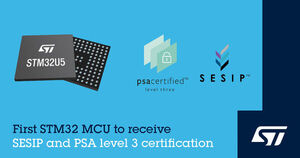
STMicroelectronics’ STM32U5 General-Purpose Microcontrollers Achieve PSA Certified Level-3 and SESIP3 Security Certifications
"STMicroelectronics has announced PSA Certified Level-3 and SESIP 3 certifications for its general-purpose secure STM32U585* microcontroller, passing tests for logical, board, and basic physical resistance that confirm a substantial level of cyber protection. With enhanced tamper resistance and software protection, the STM32U585 is also suitable for controlling PIN Transaction Security (PTS) equipment that must satisfy Payment Card Industry Security Standards Council (PCI SSC) requirements. As a secure, general-purpose microcontroller, the STM32U585 offers an all-in-one solution that simplifies the design and production of Point-Of-Sale (POS) and self-service payment terminals. Typically, achieving recognition as an official PTS Approved Device requires a dedicated security chip to resist online and side-channel attacks, with a separate microcontroller (MCU) to manage features such as the keyboard, display, and USB connection. The STM32U585 can now consolidate all these capabilities, enabling a simplified design and streamlining production logistics from purchasing and inventory management to final assembly. Terminal makers can also test and certify their products to applicable standards such as PCI PTS v6 more quickly and easily." [...]

New Highly Integrated Renesas PMIC Optimized For RZ/G2L And V2L MPUs Delivers Complete Power Solution To Reduce Design Time
"Renesas Electronics Corporation (TSE:6723), a premier supplier of advanced semiconductor solutions, today introduced the RAA215300 PMIC (Power Management IC) optimized to complement Renesas’ RZ/V2L and RZ/G2L microprocessors (MPUs) designed for AI-enabled applications. The new high performance PMIC offers a wide range of features, including nine channels, a built-in charger and a real-time clock. The high integration of the new device reduces design complexity, speeding time-to-market for customers. The RAA215300 includes six buck regulators, three LDOs and a coin cell/supercap charger. It supports DDR4, DDR4L, DDR3 and DDR3L memory with dedicated VREF, VTT and VPP rails. The new PMIC enables four-layer printed-circuit boards, which reduce costs." [...]

What if Highways Were Electric? Germany Is Testing the Idea
"An electrified highway is theoretically the most efficient way to eliminate truck emissions. But the political obstacles are daunting. On a highway south of Frankfurt recently, Thomas Schmieder maneuvered his Scania tractor-trailer and its load of house paint into the far right lane. Then he flicked a switch you won’t find on most truck dashboards. Outside the cab a contraption started to unfold from the roof, looking like a clothes-drying rack with an upside-down sled welded to the top. As Mr. Schmieder continued driving, a video display showed the metal skids rising up and pushing gently against wires running overhead." [...]
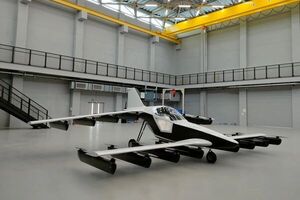
Tetra Aviation debuts single-seat buy 'n' fly personal eVTOL
"Japan's Tetra Aviation won a hundred-grand "disruptor award" at the GoFly personal flight contest last year, and has now presented its first commercial product at OshKosh: a 33-rotor Mk5 personal eVTOL it hopes to begin delivering to buyers in 2022. The Mk5 is a lightweight single-seat lift-and-cruise-style aircraft running 32 vertical lift rotors distributed across long, thin wings at the front and rear of a small cabin, with a single pusher prop on the rear for cruise flight. Its frame is mainly aluminum, and the bodywork is a lightweight carbon fiber reinforced polymer with some aramid fibers in there too. The prototype shown at OshKosh this year, which has already flown, is a decent size at 8.62 m (28.2 feet) wide, 6.15 m (20.2 ft) long and 2.51 m (8.2 ft) high, so it'll take up a fair bit of room in the garage. With a 13.5-kWh battery pack, it weighs 488 kg (1,076 lb) empty and has a maximum takeoff weight of 567 kg (1,250 lb) – leaving room for a 79-kg (174-lb) pilot or less. Many of these figures will move north for the production version, which is designed to take at least a 91-kg (200-lb) pilot, and fly at cruise speeds up to 160 km/h (100 mph) for VTOL ranges as high as 160 km (100 miles) on a charge." [...]

X-59 Resembles Actual Aircraft
"A heavy chorus of bolting and machinery filled the X-59 Quiet SuperSonic Technology, or QueSST, assembly building as engineers, system technicians, and aircraft fabricators worked to merge the major aircraft sections together, making it look like an actual aircraft for the first time since the initial cut of metal in 2018. "We’ve now transitioned from being a bunch of separate parts sitting around on different parts of the production floor to an airplane,” said Jay Brandon, NASA chief engineer for the Low Boom Flight Demonstrator (LBFD) project. NASA’s X-59 QueSST is under construction at Lockheed Martin Skunk Works in Palmdale, California, and is designed to fly at supersonic speeds – approximately 660 mph at sea level - without producing a startling sonic boom for people on the ground. NASA will work with U.S. communities to understand their response to the aircraft’s sound and provide that data to regulators, which could change the rules that currently ban supersonic flight over land, cutting travel time in half for air travelers in the near future. The Merger With great precision and accuracy, the team used features on the structure to precisely self-locate the aircraft’s wing, tail assembly, and fuselage or forward section, then employed a series of laser projections to verify the precise fit. “The extensive use of features and pre-drilled, full-size fastener holes has significantly reduced the time it takes to locate and fit parts, especially mating large assemblies like this,” said David Richardson, Lockheed Martin program director." [...]
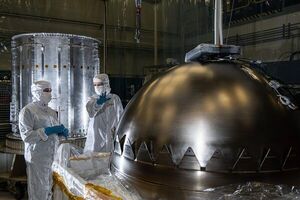
A Few Steps Closer to Europa: Spacecraft Hardware Makes Headway
"Take a closer look at the complex choreography involved in building NASA’s Europa Clipper as the mission to explore Jupiter’s moon Europa approaches its 2024 launch date. The hardware that makes up NASA’s Europa Clipper spacecraft is rapidly taking shape, as engineering components and instruments are prepared for delivery to the main clean room at the agency’s Jet Propulsion Laboratory in Southern California. In workshops and labs across the country and in Europe, teams are crafting the complex pieces that make up the whole as mission leaders direct the elaborate choreography of building a flagship mission. The massive 10-foot-tall (3-meter-tall) propulsion module recently moved from NASA’s Goddard Space Flight Center in Greenbelt, Maryland, to the Johns Hopkins Applied Physics Laboratory (APL) in Laurel, Maryland, where engineers will install electronics, radios, antennas, and cabling. The spacecraft’s thick aluminum vault, which will protect Europa Clipper’s electronics from Jupiter’s intense radiation, is nearing completion at JPL. The building and testing of the science instruments at universities and partner institutions across the country continue as well." [...]
Ciência e Tecnologia
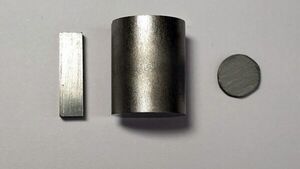
New material offers ecofriendly solution to converting waste heat into energy
"Purified tin selenide has extraordinarily high thermoelectric performance Perseverance, NASA’s 2020 Mars rover, is powered by something very desirable here on Earth: a thermoelectric device, which converts heat to useful electricity. On Mars, the heat source is the radioactive decay of plutonium, and the device’s conversion efficiency is 4-5%. That’s good enough to power Perseverance and its operations but not quite good enough for applications on Earth. A team of scientists from Northwestern University and Seoul National University in Korea now has demonstrated a high-performing thermoelectric material in a practical form that can be used in device development. The material — purified tin selenide in polycrystalline form — outperforms the single-crystal form in converting heat to electricity, making it the most efficient thermoelectric system on record. The researchers were able to achieve the high conversion rate after identifying and removing an oxidation problem that had degraded performance in earlier studies." [...]

Running quantum software on a classical computer
"Two physicists, from EPFL and Columbia University, have introduced an approach for simulating the quantum approximate optimization algorithm using a traditional computer. Instead of running the algorithm on advanced quantum processors, the new approach uses a classical machine-learning algorithm that closely mimics the behavior of near-term quantum computers. In a paper published in Nature Quantum Information, EPFL professor Giuseppe Carleo and Matija Medvidović, a graduate student at Columbia University and at the Flatiron Institute in New York, have found a way to execute a complex quantum computing algorithm on traditional computers instead of quantum ones. The specific “quantum software” they are considering is known as Quantum Approximate Optimization Algorithm (QAOA) and is used to solve classical optimization problems in mathematics; it’s essentially a way of picking the best solution to a problem out of a set of possible solutions. “There is a lot of interest in understanding what problems can be solved efficiently by a quantum computer, and QAOA is one of the more prominent candidates,” says Carleo. Ultimately, QAOA is meant to help us on the way to the famed “quantum speedup”, the predicted boost in processing speed that we can achieve with quantum computers instead of conventional ones." [...]

New viable means of storing information for quantum technologies?
"Quantum information could be behind the next technological revolution. By analogy with the bit in classical computing, the qubit is the basic element of quantum computing. However, demonstrating the existence of this information storage unit and using it remains complex, and hence limited. In a study published on 3 August 2021 in Physical Review X, an international research team consisting of CNRS researcher Fabio Pistolesi1 and two foreign researchers used theoretical calculations to show that it is possible to realize a new type of qubit, in which information is stored in the oscillation amplitude of a carbon nanotube. These nanotubes can perform a large number of oscillations without diminishing, which shows their low level of interaction with the environment, and makes them excellent potential qubits. This property would enable for greater reliability in quantum computation." [...]
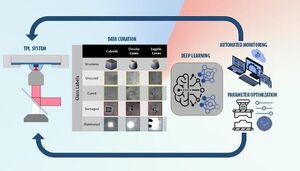
Machine learning model may perfect 3D nanoprinting
"Two-photon lithography (TPL) — a widely used 3D nanoprinting technique that uses laser light to create 3D objects — has shown promise in research applications but has yet to achieve widespread industry acceptance due to limitations on large-scale part production and time-intensive setup. Capable of printing nanoscale features at a very high resolution, TPL uses a laser beam to build parts, focusing an intense beam of light on a precise spot within a liquid photopolymer material. The volumetric pixels, or “voxels,” harden the liquid to a solid at each point the beam hits and the uncured liquid is removed, leaving behind a 3D structure. Building a high-quality part with the technique requires walking a fine line: too little light and a part can’t form, too much and it causes damage. For operators and engineers, determining the correct light dosage can be a laborious manual process. Lawrence Livermore National Laboratory (LLNL) scientists and collaborators turned to machine learning to address two key barriers to industrialization of TPL: monitoring of part quality during printing and determining the right light dosage for a given material." [...]

Scientists Release New AI-based Tools to Accelerate Functional Electronic Materials Discovery
"An interdisciplinary team of scientists from Northwestern Engineering and the Massachusetts Institute of Technology has used artificial intelligence (AI) techniques to build new, free, and easy-to-use tools that allow scientists to accelerate the rate of discovery and study of materials that exhibit a metal-insulator transition (MIT), as well as identify new features that can describe this class of materials. One of the keys to making microelectronic devices faster and more energy efficient, as well as designing new computer architectures, is the discovery of new materials with tunable electronic properties. The electrical resistivity of MITs may exhibit metallic or insulating electronic behavior, depending on the properties of the environment. Although some materials that exhibit MITs have already been implemented in electronic devices, only fewer than 70 with this property are known, and even fewer exhibit the performance necessary for integration into new electronic devices. Further, these materials switch electrically due to a variety of mechanisms, which makes obtaining a general understanding of this class of materials difficult. “By providing a database, online classifier, and new set of features, our work opens new pathways to the understanding and discovery in this class of materials,” said James Rondinelli, Morris E. Fine Professor in Materials and Manufacturing at the McCormick School of Engineering and the study’s corresponding primary investigator." [...]

Q-CTRL unveils machine learning technique to pinpoint quantum errors
"Method separates 'real' from background noise in quantum systems Professor Michael Biercuk's quantum tech startup makes research strides through continued collaboration with the University to enhance quantum computing performance. Researchers at the University of Sydney and quantum control startup Q-CTRL have announced a way to identify sources of error in quantum computers through machine learning, providing hardware developers the ability to pinpoint performance degradation with unprecedented accuracy and accelerate paths to useful quantum computers. A joint scientific paper detailing the research, titled “Quantum Oscillator Noise Spectroscopy via Displaced Cat States,” has been published in Physical Review Letters, the world’s premier physical science research journal and flagship publication of the American Physical Society (APS Physics). Focused on reducing errors caused by environmental “noise” - the Achilles’ heel of quantum computing - the University of Sydney team developed a technique to detect the tiniest deviations from the precise conditions needed to execute quantum algorithms using trapped ion and superconducting quantum computing hardware. These are the core technologies used by world-leading industrial quantum computing efforts at IBM, Google, Honeywell, IonQ, and others. The University team is based at the Quantum Control Laboratory led by Professor Michael Biercuk in the Sydney Nanoscience Hub." [...]
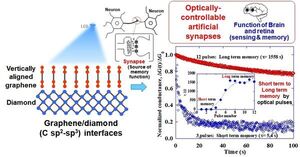
Towards next-gen computers: Mimicking brain functions with graphene-diamond junctions
"Scientists from Japan mimic the brain's functions with junctions between vertically aligned graphene and diamond The human brain holds the secret to our unique personalities. But did you know that it can also form the basis of highly efficient computing devices? Researchers from Nagoya University, Japan, recently showed how to do this, through graphene-diamond junctions that mimic some of the human brain's functions. But, why would scientists try to emulate the human brain? Today, existing computer architectures are subjected to complex data, limiting their processing speed. The human brain, on the other hand, can process highly complex data, such as images, with high efficiency." [...]

Australian mathematician reveals worlds's oldest example of applied geometry
"A UNSW Sydney scientist has revealed that an ancient clay tablet could be the oldest and most complete example of applied geometry. The surveyor’s field plan from the Old Babylonian period shows that ancient mathematics was more advanced than previously thought. A UNSW mathematician has revealed the origins of applied geometry on a 3700-year-old clay tablet that has been hiding in plain sight in a museum in Istanbul for over a century. The tablet – known as Si.427 – was discovered in the late 19th century in what is now central Iraq, but its significance was unknown until the UNSW scientist’s detective work was revealed today. Most excitingly, Si.427 is thought to be the oldest known example of applied geometry – and in the study released today in the Foundations of Science, the research also reveals a compelling human story of land surveying. “Si.427 dates from the Old Babylonian (OB) period – 1900 to 1600 BCE,” says lead researcher Dr Daniel Mansfield from UNSW Science’s School of Mathematics and Statistics." [...]

NIST’s Quantum Crystal Could Be a New Dark Matter Sensor
"Physicists at the National Institute of Standards and Technology (NIST) have linked together, or “entangled,” the mechanical motion and electronic properties of a tiny blue crystal, giving it a quantum edge in measuring electric fields with record sensitivity that may enhance understanding of the universe. The quantum sensor consists of 150 beryllium ions (electrically charged atoms) confined in a magnetic field, so they self-arrange into a flat 2D crystal just 200 millionths of a meter in diameter. Quantum sensors such as this have the potential to detect signals from dark matter — a mysterious substance that might turn out to be, among other theories, subatomic particles that interact with normal matter through a weak electromagnetic field. The presence of dark matter could cause the crystal to wiggle in telltale ways, revealed by collective changes among the crystal’s ions in one of their electronic properties, known as spin. As described in the Aug. 6 issue of Science, researchers can measure the vibrational excitation of the crystal — the flat plane moving up and down like the head of a drum — by monitoring changes in the collective spin. Measuring the spin indicates the extent of the vibrational excitation, referred to as displacement." [...]
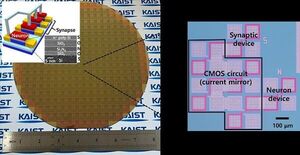
Brain-Inspired Highly Scalable Neuromorphic Hardware Presented
"Neurons and synapses based on single transistor can dramatically reduce the hardware cost and accelerate the commercialization of neuromorphic hardware KAIST researchers fabricated a brain-inspired highly scalable neuromorphic hardware by co-integrating single transistor neurons and synapses. Using standard silicon complementary metal-oxide-semiconductor (CMOS) technology, the neuromorphic hardware is expected to reduce chip cost and simplify fabrication procedures. The research team led by Yang-Kyu Choi and Sung-Yool Choi produced a neurons and synapses based on single transistor for highly scalable neuromorphic hardware and showed the ability to recognize text and face images. This research was featured in Science Advances on August 4. Neuromorphic hardware has attracted a great deal of attention because of its artificial intelligence functions, but consuming ultra-low power of less than 20 watts by mimicking the human brain. To make neuromorphic hardware work, a neuron that generates a spike when integrating a certain signal, and a synapse remembering the connection between two neurons are necessary, just like the biological brain." [...]

Decades of research brings quantum dots to brink of widespread use
"Review article in Science covers a wide range of breakthroughs, including Los Alamos’ role in key advances A new article in Science magazine gives an overview of almost three decades of research into colloidal quantum dots, assesses the technological progress for these nanometer-sized specs of semiconductor matter, and weighs the remaining challenges on the path to widespread commercialization for this promising technology with applications in everything from TVs to highly efficient sunlight collectors. “Thirty years ago, these structures were just a subject of scientific curiosity studied by a small group of enthusiasts. Over the years, quantum dots have become industrial-grade materials exploited in a range of traditional and emerging technologies, some of which have already found their way into commercial markets,” said Victor I. Klimov, a coauthor of the paper and leader of the team conducting quantum dot research at Los Alamos National Laboratory. Many advances described in the Science article originated at Los Alamos, including the first demonstration of colloidal quantum dot lasing, the discovery of carrier multiplication, pioneering research into quantum dot light emitting diodes (LEDs) and luminescent solar concentrators, and recent studies of single-dot quantum emitters. Using modern colloidal chemistry, the dimensions and internal structure of quantum dots can be manipulated with near-atomic precision, which allows for highly accurate control of their physical properties and thereby behaviors in practical devices. A number of ongoing efforts on practical applications of colloidal quantum dots have exploited size-controlled tunability of their emission color and high-emission quantum yields near the ideal 100 percent limit." [...]
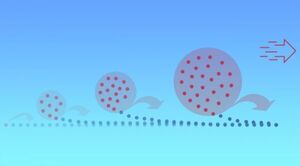
New Approach to Information Transfer Reaches Quantum Speed Limit
"Even though quantum computers are a young technology and aren’t yet ready for routine practical use, researchers have already been investigating the theoretical constraints that will bound quantum technologies. One of the things researchers have discovered is that there are limits to how quickly quantum information can race across any quantum device. These speed limits are called Lieb-Robinson bounds, and, for several years, some of the bounds have taunted researchers: For certain tasks, there was a gap between the best speeds allowed by theory and the speeds possible with the best algorithms anyone had designed. It’s as though no car manufacturer could figure out how to make a model that reached the local highway limit. But unlike speed limits on roadways, information speed limits can’t be ignored when you’re in a hurry—they are the inevitable results of the fundamental laws of physics. For any quantum task, there is a limit to how quickly interactions can make their influence felt (and thus transfer information) a certain distance away." [...]
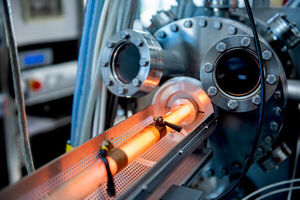
How cola still tingles after a year
"A few nanometers of thin quartz-like coatings can multiply the shelf life of food, enable brilliant OLED TV pictures or separate gases from each other. When it comes to recycling, they can simply be neglected. When you add energy to gases or gas mixtures, a plasma can be created, and inside it things go haywire: atoms turn into ions, free electrons whiz through space and collide with everything, some ingredients decay, other substances form anew. Depending on what is added to the starting material, plasmas can therefore be used to produce larger compounds. Hydrocarbons and silicon hydrogens are turned into long chains of molecules called polymers. “If you want to etch with plasmas that tend to form polymers, it’s bad because the nanoparticles that form are a hindrance,” explains Professor Peter Awakowicz, holder of the Chair of General Electrical Engineering and Plasma Technology at RUB." [...]
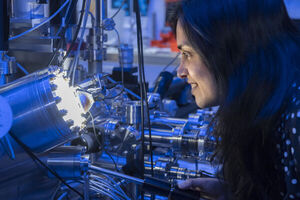
Mixing A Cocktail Of Topology And Magnetism For Future Electronics
"A new Monash review throws the spotlight on recent research in heterostructures of topological insulators and magnetic materials. In such heterostructures, the interesting interplay of magnetism and topology can give rise to new phenomena such as quantum anomalous Hall insulators, axion insulators and skyrmions. All of these are promising building blocks for future low-power electronics. Provided suitable candidate materials are found, there is a possibility to realise these exotic states at room temperature and without any magnetic field, hence aiding FLEET’s search for future low-energy, beyond-CMOS electronics. FINDING THE RIGHT MIX OF TOPOLOGY AND MAGNETISM “Our aim was to investigate promising new methods of achieving the quantum Hall effect”, says the new study’s lead author, Dr Semonti Bhattacharyya at Monash University. The quantum Hall effect (QHE) is a topological phenomenon that allows high-speed electrons to flow at a material’s edge, which is potentially useful for future low- energy electronics and spintronics." [...]
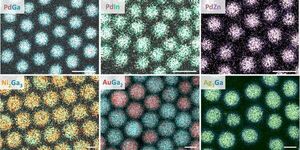
A promising breakthrough: Nanocrystals made of amalgam
"Researchers at ETH have managed to produce nanocrystals made of two different metals using an amalgamation process whereby a liquid metal penetrates a solid one. This new and surprisingly intuitive technique makes it possible to produce a vast array of intermetallic nanocrystals with tailored properties for diverse applications. Nanocrystals are nanometre-sized spheres consisting of regularly arranged atoms. Owing to their advantageous properties, they are on the rise in several technologies. Semiconductor nanocrystals, for instance, are used in new generation television screens. More recently, so-called intermetallic nanocrystals, in which two different metals combine to form a crystal lattice, have made a name for themselves as they promise improved and unique applications." [...]
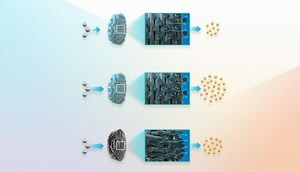
LLNL optimizes flow-through electrodes for electrochemical reactors with 3D printing
"To take advantage of the growing abundance and cheaper costs of renewable energy, Lawrence Livermore National Laboratory (LLNL) scientists and engineers are 3D printing flow-through electrodes (FTEs), core components of electrochemical reactors used for converting CO2 and other molecules to useful products. As described in a paper published by the Proceedings of the National Academy of Sciences, LLNL engineers for the first time 3D-printed carbon FTEs — porous electrodes responsible for the reactions in the reactors — from graphene aerogels. By capitalizing on the design freedom afforded by 3D printing, researchers demonstrated they could tailor the flow in FTEs, dramatically improving mass transfer – the transport of liquid or gas reactants through the electrodes and onto the reactive surfaces. The work opens the door to establishing 3D printing as a “viable, versatile rapid-prototyping method” for flow-through electrodes and as a promising pathway to maximizing reactor performance, according to researchers. “At LLNL we are pioneering the use of three-dimensional reactors with precise control over the local reaction environment,” said LLNL engineer Victor Beck, the paper’s lead author. “Novel, high-performance electrodes will be essential components of next-generation electrochemical reactor architectures." [...]
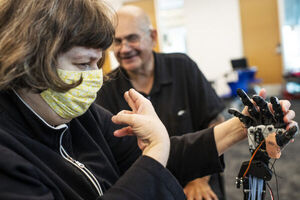
This Robot Uses Tactile Sign Language To Help Deaf-Blind People Communicate Independently
"Jaimi Lard gets into position. She cups her left hand over the device, spreading her fingers across the top of it, and raises her right hand. When Lard is ready, Samantha Johnson presses a few keys on a laptop wired to the robot and then, with a mechanical buzzing sound filling the air, the device begins to move. When the whirring stops, three of the fingers of the robotic hand are pointing directly upward, while the tips of the thumb and pointer finger are touching, forming a circle. Lard uses her left hand to feel what position the robotic hand is in, then moves her right hand to make the same sign. “F, perfect!” Johnson exclaims." [...]
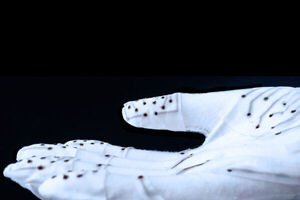
This touchy-feely glove senses and maps tactile stimuli
"The design could help restore motor function after stroke, enhance virtual gaming experiences. When you pick up a balloon, the pressure to keep hold of it is different from what you would exert to grasp a jar. And now engineers at MIT and elsewhere have a way to precisely measure and map such subtleties of tactile dexterity. The team has designed a new touch-sensing glove that can “feel” pressure and other tactile stimuli. The inside of the glove is threaded with a system of sensors that detects, measures, and maps small changes in pressure across the glove. The individual sensors are highly attuned and can pick up very weak vibrations across the skin, such as from a person’s pulse." [...]

Researchers kick-start magnetic spin waves at nanoscale in pursuit of low energy computing
"An international team from Delft, Lancaster, Nijmegen, Kiev and Salerno has demonstrated a new technique to generate magnetic waves that propagate through the material at a speed much faster than the speed of sound. These so-called spin waves produce a lot less heat than conventional electric currents, making them promising candidates for future computation devices with significantly reduced power consumption. Physicists and engineers from all around the world are constantly thinking of ways to improve the performance of data processing devices. Many of their ideas revolve around substituting the electrical currents, which carry the signals in conventional electronics, with waves. Waves are coherent excitations, which means that information can be encoded into both the amplitude and the phase of the wave. Interference and diffraction, natural phenomena for a wave of any nature, enable the creation of so-called wave-based logic circuits, the tiny building blocks for future data processing applications." [...]

Lunar samples solve mystery of the moon’s supposed magnetic shield
"Rochester geophysicists’ latest findings will inform the next generation of moon exploration. In 2024, a new age of space exploration will begin when NASA sends astronauts to the moon as part of their Artemis mission, a follow-up to the Apollo missions of the 1960s and 1970s. Some of the biggest questions that scientists hope to explore include determining what resources are found in the moon’s soil and how those resources might be used to sustain life. In a paper published in the journal Science Advances, researchers at the University of Rochester, leading a team of colleagues at seven other institutions, report their findings on a major factor that influences the types of resources that may be found on the moon: whether or not the moon has had a long-lived magnetic shield at any point in its 4.53 billion-year history. The presence or absence of a shield matters because magnetic shields protect astronomical bodies from harmful solar radiation. And the team’s findings contradict some longstanding assumptions." [...]

Getting smart about off-grid desalination
"Theoretical modeling helps boost the efficiency of a device that generates both clean drinking water and electricity. Small changes in membrane design can have a large impact on the performance of a new technology developed at KAUST that uses waste heat from solar cells for seawater desalination. Solar panels can become incredibly hot — more than 40 degrees Celsius warmer than the surrounding air temperature in arid regions. These conditions arise because silicon photovoltaic cells typically convert only one-quarter of absorbed solar energy into electricity while the remainder heats up the cell. Extreme operating temperatures reduce the cell’s efficiency and lifespan even further. In 2019, Peng Wang and his team realized that waste solar-cell heat could be used for water purification." [...]
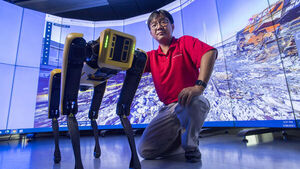
Robot Dog Makes Infrastructure Maintenance a Walk in the Park
"Able to climb stairs, navigate rough terrain, and respond to commands, Spot, the mobile robotic dog, offers researchers an autonomous technology for innovations in infrastructure maintenance and repair Jie Gong thinks robots hold the key to mitigating dangers that can occur during industrial inspections and can serve as innovative tools to maintain the transportation network and aging infrastructure throughout the country. “Infrastructure repair and maintenance projects heavily rely on construction crews equipped with machinery tools,” says Gong, an associate professor at the Rutgers University School of Engineering. “Often these traditional methods call for the shutdown of roads and bridges that can be costly and disrupt traffic, put workers in live traffic conditions that can be dangerous, and require the inspection of places that are hard to reach by people.” Gong is part of a team examining ways to automate infrastructure inspection projects in a way that is efficient, safe, and accurate. He recently acquired the mobile robotic dog, Spot, as part of a Center for Advanced Infrastructure and Transportation (CAIT) University Transportation Center (UTC) research grant supporting maintenance and robotic systems. The purchase was a collaborative effort between the Rutgers University School of Engineering and its strategic equipment funds, the Department of Civil and Environmental Engineering, and Rutgers CAIT. The new robotic technology, which is part of a growing industry trend, can navigate rough terrain and address some of the dangers workers may face doing inspections." [...]
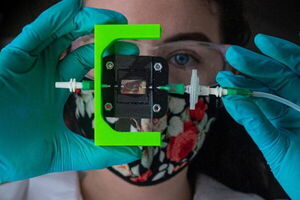
Rice team creating insulin-producing implant for Type 1 diabetes
"JDRF funds creation of implant to automatically regulate blood glucose levels Rice University bioengineers are using 3D printing and smart biomaterials to create an insulin-producing implant for Type 1 diabetics. The three-year project is a partnership between the laboratories of Omid Veiseh and Jordan Miller that’s supported by a grant from JDRF, the leading global funder of diabetes research. Veiseh and Miller will use insulin-producing beta cells made from human stem cells to create an implant that senses and regulates blood glucose levels by responding with the correct amount of insulin at a given time. Veiseh, an assistant professor of bioengineering, has spent more than a decade developing biomaterials that protect implanted cell therapies from the immune system. Miller, an associate professor of bioengineering, has spent more than 15 years researching techniques to 3D print tissues with vasculature, or networks of blood vessels. “If we really want to recapitulate what the pancreas normally does, we need vasculature,” Veiseh said." [...]

New research infuses equity principles into the algorithm development process
"In the U.S., the place where one was born, one’s social and economic background, the neighborhoods in which one spends one’s formative years, and where one grows old are factors that account for a quarter to 60% of deaths in any given year, partly because these forces play a significant role in occurrence and outcomes for heart disease, cancer, unintentional injuries, chronic lower respiratory diseases, and cerebrovascular diseases — the five leading causes of death. While data on such “macro” factors is critical to tracking and predicting health outcomes for individuals and communities, analysts who apply machine-learning tools to health outcomes tend to rely on “micro” data constrained to purely clinical settings and driven by healthcare data and processes inside the hospital, leaving factors that could shed light on healthcare disparities in the dark. Researchers at the NYU Tandon School of Engineering and NYU School of Global Public Health (NYU GPH), in a new perspective, “Machine learning and algorithmic fairness in public and population health,” in Nature Machine Intelligence, aim to activate the machine learning community to account for “macro” factors and their impact on health. Thinking outside the clinical “box” and beyond the strict limits of individual factors, Rumi Chunara, associate professor of computer science and engineering at NYU Tandon and of biostatistics at the NYU GPH, found a new approach to incorporating the larger web of relevant data for predictive modeling for individual and community health outcomes. “Research of what causes and reduces equity shows that to avoid creating more disparities it is essential to consider upstream factors as well,” explained Chunara. She noted, on the one hand, the large body of work on AI and machine learning implementation in healthcare in areas like image analysis, radiography, and pathology, and on the other the strong awareness and advocacy focused on such areas as structural racism, police brutality, and healthcare disparities that came to light around the COVID-19 pandemic." [...]
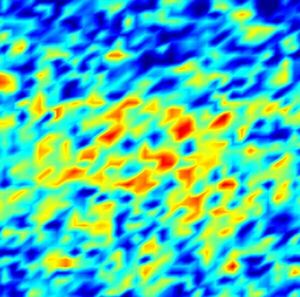
When vibrations increase on cooling: Anti-freezing observed
"An international team has observed an amazing phenomenon in a nickel oxide material during cooling: Instead of freezing, certain fluctuations actually increase as the temperature drops. Nickel oxide is a model system that is structurally similar to high-temperature superconductors. The experiment shows once again that the behaviour of this class of materials still holds surprises. In virtually all matter, lower temperatures mean less movement of its microscopic components. The less heat energy is available, the less often atoms change their location or magnetic moments their direction: they freeze. An international team led by scientists from HZB and DESY has now observed for the first time the opposite behaviour in a nickel oxide material closely related to high-temperature superconductors." [...]
Projetos Maker
Diversos Projetos interessantes.
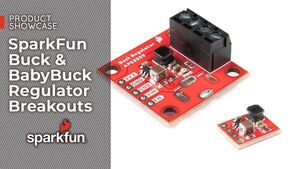
Buck Regulator Hookup Guide
"Who doesn't occasionally need power regulation? We certainly do, so we've designed the SparkFun Buck Regulator Breakout and the SparkFun BabyBuck Regulator Breakout to help us with just such a task. Starring the AP63203 from Diodes Inc, both breakout boards take advantage of the 2A synchronous buck converter that has a wide input voltage range of 3.8V to 32V and fully integrated 125mΩ high-side power MOSFET/68mΩ lowside power MOSFET to provide high-efficiency step-down DC/DC conversion. All of this snuggled up in a a low-profile, TSOT26 package that's integrated into either a 1x1" or 0.4x0.5" board. For a wide variety of power management needs - grab yourself a Buck Regulator or Baby Buck Regulator and let's dive in! " [...]
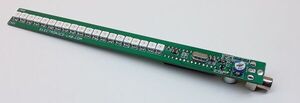
Sound to Colour Light Effects – Arduino Compatible
"This is a fun-loving project based on the Arduino platform. The project creates color light effects with sound level sense by an onboard condenser microphone. The project consists 20 x WS2812B RGB LEDs, an Atmega328 micro-controller, condenser microphone along with pre-amplifier, RCA connector, and trimmer potentiometer to direct feed audio. The project can be used in fun parties, disco parties etc. Just power the board and RGB LEDs will create different colors as per sound level. Board has the option of direct audio input or sound sense by the microphone, users may change the Arduino example code as per requirement or write their own code." [...]
WiFi Controlled Bot
"This bot implements the addition of ESP8266 for establishing a WiFi communication between the Arduino on the remote side and the bot side. In this project, ESP8266 acts as a communication device between the two Arduinos used in the Remote and on the Bot itself. The bot - side ESP8266 broadcasts a WiFi signal on which TCP communication protocol is turned on. The remote - side ESP8266 connects to that WiFi signal and sends serial data to the other as per the user input. The custom made Arduino shield on the remote side takes input and transfers the corresponding data to ESP8266 to transfer the data to the bot, after which the bot - side ESP8266 sends data to the bot side Arduino to interpret that data and do the corresponding action. " [...]

DIY Arduino Corner lamps
"Corner Lamps controlled via clap Make Lamps and put in the corner and when you enter the room, just clap and these Red and Blue lamps will turn On automatically. When you clap once again, these lamps turns Off. " [...]
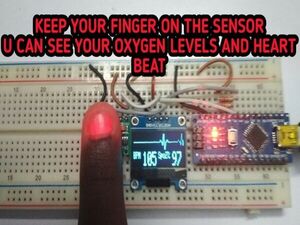
Pulse oximeter using Arduino
"Hello friends, this is an Pulse Oximeter which measures Oxygen Saturationon blood aslo measures HeartBeat rate just using your finger. At thisCORONA pandemic pulse Oximeter is very essential to measure heartbeat and oxygen levels. " [...]
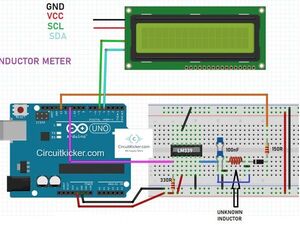
How to make inductance meter using Arduino
"This circuit gives accurate reading to all types of an inductor, we can measure unknown inductor value using this. Arduino inductor meter. This is the 1st part of our LCR tutorial in which we are going to make an inductance meter. In the upcoming parts of this series, we will upload information and circuit diagrams of the capacitor and resistance meter. Inductance meter: An inductance meter is used to measure the unknown inductor value. For more precision and accurate readings, we will use a microcontroller (Arduino) as the brain of the circuit." [...]
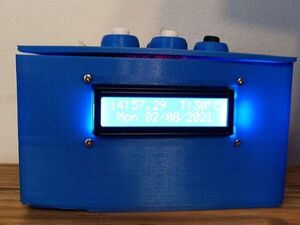
All in one clock
"Clock alarm temprture senseor and timer, all in one device using an arduino uno and RTC In this project we will make an arduino clock alarm with timer and a temperature sensor. " [...]

Arduino Nano BLE 33 Sense Game Controller
"I made this game controller by using Arduino Nano BLE 33 Sense which has onboard proximity sensor. 1) In this project I used the Arduino Nano BLE 33 Sense which has onboard proximity sensor 2) First upload the Serial.ino code When the proximity sensor detect any object it will print the word "d" in serial Monitor 3) Then run controller.py python file I this python code I used two packages one is pyserial another one is pynput packages pyserial is used to make a connection between and arduino and python and the pynput used to control and monitor the input devices like keyboard and mouse 4) After executing the python file. open notepad bring the arduino ble board close to any object the word d will typed in the note pad with out using the keyboard" [...]

SonicSurface: Phased-array for Levitation, Mid-air Tactile Feedback and Target Directional Speakers
"We will build an array of ultrasonic emitters. It has 256 emitters arranged in a 16x16 grid operating at 40 kHz with individual phase control. It can focus the acoustic power at controllable positions to create dynamic levitation of small particles and tactile feedback. You can use this for your unique artistic installations or projects. A small showcase is shown at the beggining of the video. This is a relatively hard and expensive project: requires experience with SMD components and the materials are around 200$." [...]

Floating Hexagon - Magnetic Tensegrity - 3D Printed
"... another contribution to the topic "Tensegrity". The main difference to the other models is that the tension in the middle is not created by a thread but by the attracting force of two magnets. Therefore the top is of course not as loadable as with a thread or a nylon string. But all the more interesting for the eye! After all - so I show in my video - the construction can carry light objects. The closer the magnets are to each other, the more weight the plate can carry." [...]
Wi-Fi Controlled Stepper Motor With an ESP Microcontroller
"I recently came across this video and decided to modify the project to control a stepper motor and add an OLED display. In this quick, little project, let's learn how to control a stepper motor's position from a web browser using an ESP8266 microcontroller. Let's get started! For this project, you will need: - An ESP8266 microcontroller - A Stepper Motor(Unipolar or bipolar) - A suitable stepper motor driver - A breadboard - Some breadboard wires(Or male jumpers) - A 5-volt DC power source - A 128x64 I2C OLED display(Optional)" [...]
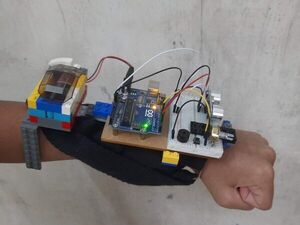
Arduino Ultrasonic Navigator for the Blind
"Bat Eyes 1.0, an Arduino device that can help blind people navigate their way, designed to replace the traditional cane. Why this? My maternal grandfather was a surgeon of ophthalmology, and dedicated his entire life to helping the visually impaired. Seeing the blind struggle in many situations in my day to day life, I decided to use my interest in robotics to help the blind, and continue my grandfather's work in a way. Since I wanted even people without phones or internet connection to use this, I made it independent of other technology like phones. I wrapped it around the arm because I felt that using their arm to navigate was something blind people could do best." [...]
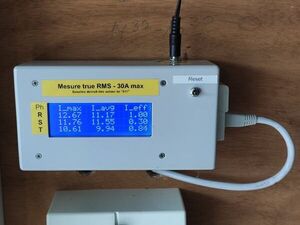
Three-Phase RMS Ammeter with Current Transformers
"Display on an LCD following parameters for each phase: - the RMS current - the maximum reached - the maximum of sliding average. Purpose: True RMS current measurement on 3 phases with current transformers. The results are displayed on a 20x4 Character HD44780 based LCD. The LCD displays the following values for each mains phase: the RMS current the maximum RMS current reached the maximum of RMS current sliding average Practical assembly: The current transformers are mounted on a veroboard plate together with the zeners for protection against disconnection. They are located at the input of the main switchboard. In the picture below you can see the mains phase wires passed through the holes of the three transformer and the cable linked to the main unit." [...]

DIY Sensitive Arduino IB Metal Detector with Discrimination
"This time I will show you how to make a sensitive metal detector also capable of discriminating between ferrous and nonferrous materials. The sensitivity is satisfactory, given that it is a relatively simple device. This is a continuation of David Crocker's project presented at the Arduino CC Forum in 2013. I decided to test its code because I did not find any evidence (Picture or video) that this metal detector was made by anyone and works well. First I made a basic version with the code presented on GitHub, to make sure of the functionality of the device and then I upgraded the code so that it has an audible signal, and on a 16 on 2 LCD display visual information about the type of object detected (Ferrous or nonferrous material) and LCD bar graph for the proximity of detected objects. The device is very simple to build and consist of only a few components: - Arduino Nano microcontroller - Operational amplifier (in my case LT1677, but you can use TL081 or 741 ) - Few resistors and capacitors - Small transistor and speaker - LCD display - 3 switches - Potentiometer - Battery - And search coils" [...]
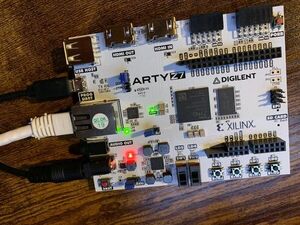
Introduction to Using AXI DMA in Embedded Linux
"This tutorial walks through an application that reads/writes data to DDR memory from the Linux userspace on the Zynq-based Arty Z7 FPGA. Story Direct memory access, or DMA as it's referred to, is an important aspect of embedded development as it a method for accessing the embedded system's main memory (typically DDR) without tying up the CPU, therefore leaving it open for performing other operations during the read/write cycle to memory. DMA simply allows for the processor to kick off a transfer to read from/write to the main system memory, then it generates an interrupt indicating the completion of the transfer. Which leaves the processor free to do other tasks until the interrupt calls its respective service routine. While the concept of DMA is straightforward enough, trying to get the full picture in one's mind of how to implement it on an FPGA with embedded processor such as the ARM-core processor in the Xilinx Zynq SoC is no small feat. Then throwing in the extra layer of complexity of how to access it from the userspace of an operating system such as Linux, just makes it even worse." [...]
Marker Beacon System with IR Sensors, Buzzer and LED
"Three marker beacon station (IR Sensors) are on the ground and detecting the aircraft is approaching the runway passing over the Markers. Marker Beacon System we incorporate all marker Beacon stations (IR Proximity Sensor) and Display (LED bulb and Buzzer). There are three IR Proximity Sensor which are working as a three marker beacon station in our project. Working principle of IR Proximity Sensor is same as radar. When object is reached within Range of it. It detect the object and gives signal to the Arduino Uno (Microcontroller)." [...]

Overleap
"Overleap is an open-source 2 DOF robotic leg that can jump and hop in a circle. Overview Overleap is an open-source low-cost 3D printed dynamic robotic leg designed be as accessible as possible. Overleap can be assembled with a 3D printer and minimal tools, without CNC milling / waterjet cutting / laser cutting like other robotic legs. The building process is tailored to be simple and seamless, from the assembly manual to the programming method, creating a unique assembly experience. Overleap is capable of executing quick and dynamic movements such as jumping and continuous hopping in a circle. This is made possible through Overleap's quasi-direct drive actuators and custom foot contact sensor." [...]

Inductance Meter
"An Arduino based meter to measure inductors. This project is a remake of an inductance meter by sagar saini. My variant has the following changes/additions: - ATtiny1614 CPU replaces Arduino UNO - LMV311 comparator replaces LM339 comparator - Battery powered with deep sleep power off mode - PCB and 3D printed case" [...]
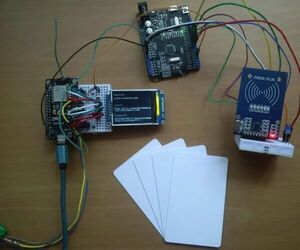
Password Vault
"In this tutorial, you'll learn how to build a password vault. A Password vault is a device that securely stores your passwords from various websites. Usually, the security of the password vault relies on the long master password. I decided to replace the long master password with four 13.56Mhz RFID cards. The advantage of using cards instead of the master password is that you don't have to remember even a single character. All you need to do to encrypt/decrypt your passwords is approximate four cards to the reader." [...]
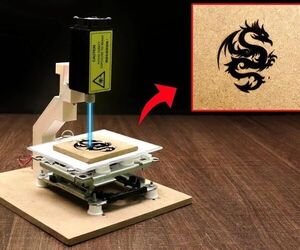
How to Make Powerfull Laser Engraver
"Hello Guys Whats up, In this instructable, I am making an Awesome mini laser engraver from old DVD writers. It's very interesting project for any electronics hobbyist & Engineers. You can use this laser engraver machine to make any kind of design, logo, art on the surface like WOOD, MDF, PLYWOOD, VNYL Paper. Parts and Materials Required - Arduino UNO (with USB cable) - 2x DVD drive stepper mechanism - 2x A4988 stepper motor driver modules (or CNC shield) - Laser with adjustable lens - 12v 2Amps power supply minimum - 1x IRFZ44N N-CHANNEL Mosfet ,etc.. Tools List: - Soldering Iron - Drill Machine - Sand paper - Wire Cutter - Superglue - 3D printer" [...]
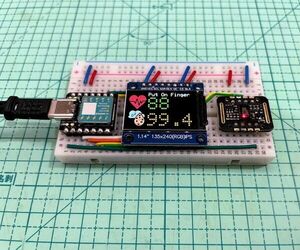
Blood Oxygen Heart Rate Meter
"This instructables show how to use MAX30102, XIAO and a tiny display to build a blood oxygen and heart rate meter. This project use Maxim Integrated MAX30102 Biosensor to detect pulse oximeter and heart rate. However, the official sample is not so accurate, so will use the MolecularD algorithm instead. MCU The pulse oximeter calculation algorithm requires some memory. Arduino classic family does not have enough memory for data buffer. And also I want all components can fit in a 400 hole breadboard, so I need a smaller one." [...]

Charging Board for Lithium-Ion Battery With Step-up to 5 Volts
"I bought a couple of lithium ion 18650 batteries to power electrical projects. However, I needed something to conveniently charge and use the batteries safely. So, I used one of the inexpensive, widely available charger modules, threw in a few switches and a step-up module. With this set up, I never have to pull the battery out of the holder. I can conveniently charge with a USB cable, and the charger will stop before the battery is damaged from over-charging. I can connect it with either male or female header pins." [...]
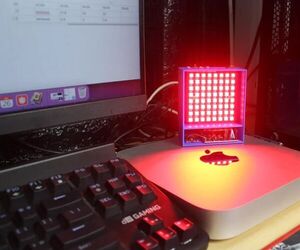
How to Make Pocket RGB Light | Arduino & WS2812B
"In this article "How to Controls WS2812B Using ESP-01 Arduino (ESP8266)". I made a custom module for the WS2812B LED using the ESP-01. With this module I can make various creations using the WS2812B LED. Among them are RGB LED Strip, RGB LED Animation and RGB Matrix. And in this article I will create an RGB Light Pocket using the WS2812B LED Matrix. I will use this LED for photography lighting." [...]

Micro Fighter BOT With Bluetooth
"Hey everyone what's up! So this is my Micro Fighter Bot or Micro Robot V2 which is an easy-to-make Micro Robot that is powered by an Arduino Nano board and L293D Motor driver IC. I'm using a Bluetooth Based Mobile terminal app which is available on the google play store to control this robot. Yes, I'm using Bluetooth here, the good old HC01 module. Materials Required 3D Printed Parts- - Base x 1 - Motor Mount x 4 - Front Shield x 1 - Pillars x 3 Components- - L293D Motor Driver IC - Arduino NANO - Custom PCB (which was provided by PCBWAY) - Micro Gear DC Motor - Female Header Pins - DC Barrel Jack - AMS1117 - 4.7uf Cap 1206 Package - 22uf Cap 1206 Package - SMD LED 0603 Package - 1K Resistance 0603 Package - HC01 Module - Battery JST Connector" [...]

The YouTube Box
"By far the biggest time sink that I have is watching YouTube. Since 2008, this website has been my main source of entertainment. I am a huge fan of the platform and many of its content creators. So, I wanted to create something that made it easier to consume my favorite creators newest content. I came up with the idea of making an old-style TV, where the buttons would change to the "Channel" to a different YouTuber and start playing the newest video. Red LED lights on the front would light up when the channel uploads a new video." [...]
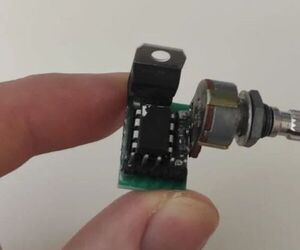
Poti PWM Control
"This article will show you how to build a PWM Controller for e.g. motors / fans that will set the PWM-Value with a poti. Note: You have to program an Attiny85 (other 8-Pin Attinys like Attiny13 should work too) in this project!I will not go into this process since it is very well explained in many other instructables ;-) Beside this, this project is considered as an easy project. It took me about 2h to develop, so you should be much faster. Bill of materials: - Attiny85 or similar microcontroller - Potentiometer (I use an 50kOhm) - Voltage regulator if the motor voltage is over 5V: We will use a L7805. - 1x5 Male Pin Header - Breadboard or PCB (if you want to solder it)" [...]
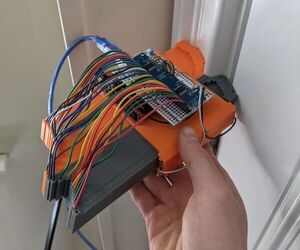
Digital Contour Gauge
"A contour gauge is a useful tool for extracting a flat, two dimensional profile from a three dimensional object. What would be even more useful, is if the tool could input into a computer, for use in CAD modeling. This is what I've attempted to do with this prototype tool. It uses Firefly for Rhino and Grasshopper to collect data from the arduino-based hardware. Follow these instructions to make your own, make changes, developments, and contribute to this project! How It Works At the heart of this tool is essentially a single linear potentiometer, with each tine of the gauge collecting an independent reading." [...]
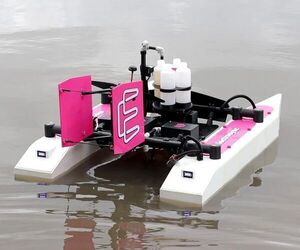
3D Printed Radio Controlled Utility Boat
"Introduction This big 3D printed big radio controlled boat is designed to house water monitoring equipment and other environmental utility systems. The hull is a catamaran design with both sides of the hull connected with carbon tubes. It is capable of carrying a large payload inside the hull as well as on the optional modular deck system. The boat is powered by a brushless motor and air propeller and steering is via above water control surfaces. The boat is designed to be radio controlled. A minimum of two channel radio equipment is required for throttle and steering, more channels are required if you would like reverse and for operating any optional auxiliary systems." [...]
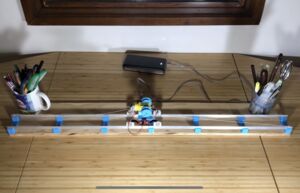
Tinkering with Linear Motion: How to build a MicroMod Rail Car
"How I made a simple linear motion system using MicroMod, Qwiic breakouts, and 3D printed parts. Lately I've been experimenting with different DIY solutions for linear motion so that I can design and build my own custom plotters and CNC machines. This simple project encapsulates the basic elements of a linear motion system. Using the MicroMod Qwiic Carrier Board as a chassis, this linear motion system could be adapted for any number of applications, or you could even just build it for fun. From the hardware store: - 1/16" thick, 1/2"x36" Aluminum Flat Bar (X2 - for rails) - Screen Door Tension Spring with Roller, Academy 2-pack (X2) - String - small wood screws (for mounting rail holders, optional)" [...]
Secção Videos
Videos interessantes.
That's all Folks!



